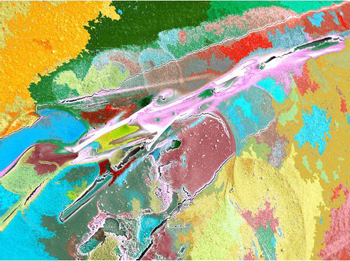Monday, March 19, 2007
Picture of the day
Image derived from black and white Scanning Electron Microscope images that was digitized and computer painted.
Copyright © Cris Orfescu. (click to see larger version)
Learn more at Cris Orfescu's Premiere Artist Portfolio
NANOART - Limited edition prints. Nano-dimensional features of different materials are revealed with an electron microscope after samples have been previously prepared. The image is created by electrons (electric charged particles) rather then photons (particles of light) as in photography. The black and white electron microscope image is digitally processed, computer painted and manipulated, and printed with archival inks on fine art archival paper or canvas - contact the artist for details. All prints are signed and numbered by the artist.
To see the entire series, visit the Nanotechnology Now Gallery.
Quote of the day
"The medicine of the future will be preventive in nature. Farewell, therapeutic care. Instead of investing enormous budgets in treating chronic diseases, a routine scan of healthy people will identify the potential for the disease even before it develops. Nanotechnology, molecular imaging and microscopic silicon chips will be the magic wand that eliminates from our lives the three main killers: cancer, heart disease and strokes. Health-care costs will drop dramatically when diseases are eradicated before they appear, and this process will allow funds to be channeled into other areas, leading to economic growth.
Hey docs, your time's almost up."
~Elisha Bar-Meir (http://www.haaretz.com/hasen/spages/838380.html)
Hey docs, your time's almost up."
~Elisha Bar-Meir (http://www.haaretz.com/hasen/spages/838380.html)
Nanomedicine at Johns Hopkins
As anyone who has been reading nanotech news for any part of the past few years knows, the impact that nanotechnologies will play on medicine is potentially enormous. Nanotechnologies will play a role in the screening, diagnosis, monitoring and treatment of disease, and will likely be a major contributor to the continued lengthening of the human lifespan as well as the greater enjoyment of those years.
The following is just one of many interviews I did as Editor of Nanotechnology Now on nanomedicine.
Here is an excerpt of my interview with Dr. Peter Searson, director for the Johns Hopkins Institute for NanoBioTechnology. He is also a professor in Materials Science and Engineering in the Whiting School of Engineering and is Associate Director of the Materials Research Science and Engineering Center.
RR: Looking out ten years, what are your hopes regarding medical diagnostics and treatments stemming from our understanding of the nanoscale?
Very simply, we will develop new scientific tools and create new technologies for the diagnosis and treatment of diseases and medical conditions. We will develop new tools will allow us to develop a better understanding of how cells function, and misfunction, at the molecular level. Research will also focus on the development of new diagnostic and therapeutic strategies, for example, for the early detection and treatment of cancer.
Read the entire interview here:
http://www.nanotech-now.com/products/nanonewsnow/issues/036/036.htm#Searson
The following is just one of many interviews I did as Editor of Nanotechnology Now on nanomedicine.
Here is an excerpt of my interview with Dr. Peter Searson, director for the Johns Hopkins Institute for NanoBioTechnology. He is also a professor in Materials Science and Engineering in the Whiting School of Engineering and is Associate Director of the Materials Research Science and Engineering Center.
RR: Looking out ten years, what are your hopes regarding medical diagnostics and treatments stemming from our understanding of the nanoscale?
Very simply, we will develop new scientific tools and create new technologies for the diagnosis and treatment of diseases and medical conditions. We will develop new tools will allow us to develop a better understanding of how cells function, and misfunction, at the molecular level. Research will also focus on the development of new diagnostic and therapeutic strategies, for example, for the early detection and treatment of cancer.
Read the entire interview here:
http://www.nanotech-now.com/products/nanonewsnow/issues/036/036.htm#Searson
Subscribe to:
Comments (Atom)










